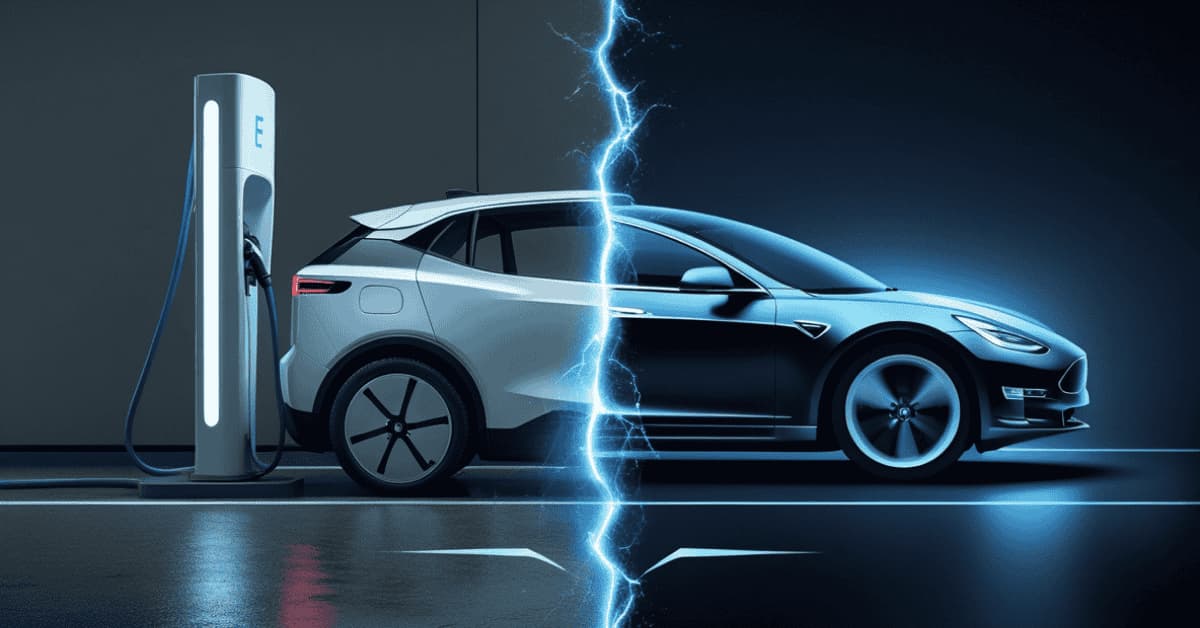Electric vehicles (EVs) are no longer just a trend; they’re a major part of our future. But with any new technology, especially one that uses powerful batteries, it’s natural to have questions and concerns. The biggest one we hear is: “Are EV batteries safe?”
The short answer is yes, they’re incredibly safe. In fact, studies show that EVs are significantly less likely to catch fire than gasoline-powered cars. The reason for this high level of safety isn’t luck; it’s a result of sophisticated engineering and a multi-layered approach to protection. Think of an EV battery not as a single power block, but as a well-guarded fortress with a smart brain and a tough shell.
In this article, we’ll take a deep dive into the fascinating world of EV battery safety. We’ll explore the critical features that prevent problems before they start and give you practical, easy-to-understand advice on how you can play a role in keeping your EV’s battery healthy and safe.
The Brain of the Battery: Battery Management System (BMS)
At the heart of every lithium-ion EV battery pack is the Battery Management System (BMS). This isn’t just a simple circuit; it’s a highly intelligent electronic system that acts as the battery’s watchful guardian, constantly monitoring and managing its every function.
A single EV battery pack contains hundreds or even thousands of individual battery cells. The BMS’s job is to ensure every one of these cells behaves as it should. It keeps a close eye on three critical metrics:
- Voltage: The BMS ensures that no cell is overcharged or over-discharged. If a cell’s voltage gets too high or too low, the BMS will intervene, shutting off the power flow to prevent damage and potential failure.
- Temperature: Lithium-ion batteries are sensitive to temperature. The BMS monitors temperatures across the entire pack. If a cell starts to get too hot, the BMS activates the vehicle’s thermal management system to cool it down.
- Current: During both charging and driving, the BMS regulates the flow of electricity to prevent a short circuit or an unsafe current that could lead to overheating.
One of the most important functions of the BMS is cell balancing. Over time, some cells may charge and discharge at slightly different rates due to tiny manufacturing differences. The BMS corrects this by “balancing” the charge among all the cells. This ensures that the entire pack works together efficiently and extends its lifespan. Without the BMS, an EV battery pack would quickly become unstable and unusable.
Physical and Structural Safeguards
Battery safety doesn’t stop with a smart brain; it’s built into the physical design of the vehicle. The entire battery pack is a marvel of engineering, designed to withstand extreme forces.
1. Armored Casing and Enclosure
The battery pack is housed in a robust, armored casing, usually made of reinforced steel or aluminum. This protective shell is designed to resist physical damage from road debris or in the event of a collision. The battery is typically positioned low in the vehicle’s chassis, which not only improves the car’s handling but also shields it with the car’s main frame, placing it in a highly protected zone.
The enclosure also has a high Ingress Protection (IP) rating, such as IP67 or IP68. This means it’s sealed against dust and can be submerged in water for a period of time without any damage. This is crucial for safety in floods or deep puddles.
2. Module and Cell Design
Inside the armored casing, the thousands of battery cells are not just thrown in together. They are organized into smaller groups called modules. This modular design is a key safety feature. If one cell were to fail, the issue would likely be contained within its module, preventing a domino effect. Manufacturers often use special fire-retardant materials and barriers between these modules to stop a fire from spreading.
This design is a direct countermeasure against a phenomenon called thermal runaway, which is a self-propagating chain reaction where a single overheated cell causes its neighbors to overheat, leading to a fire. The physical barriers, along with the constant monitoring by the BMS, are a dual-layer defense against this rare but dangerous event.
Advanced Thermal Management Systems
Controlling heat is arguably the most critical component of EV battery safety. Lithium-ion batteries perform best and are safest within a narrow temperature range. Too hot, and they risk failure; too cold, and their performance and charging speed drop dramatically.
Modern EVs use sophisticated liquid-cooling systems. These systems circulate a special coolant through a network of pipes or plates that run around the battery cells. This process actively removes heat from the battery during operation and fast charging, and can even heat the battery in cold weather to prepare it for charging.
Some thermal management systems are so advanced they can:
- Precondition the battery: When you enter a destination into your car’s navigation that includes a fast charger, the system will start heating or cooling the battery to the ideal temperature for charging. This ensures the battery can accept the fastest possible charge safely.
- Use a heat pump: Some EVs use a heat pump to either cool or heat the battery, which is a highly efficient way to manage temperature and conserve energy, especially in colder climates.
The Electrical Safety Net
Beyond the physical structure and the BMS, EV batteries have several electrical safety features that are just as important.
1. High Voltage Interlock Loop (HVIL)
The HVIL is a safety circuit that runs through all the high-voltage connections in the car. It’s a continuous loop. If a high-voltage connector becomes loose or is disconnected—whether by a service technician or in an accident—the HVIL immediately breaks the loop and shuts down the entire high-voltage system. This prevents electric shock and arc flashes, which are a major safety concern.
2. Fuses and Relays
EV batteries have multiple layers of fuses. There are fuses at the cell level, the module level, and the pack level. These fuses act like circuit breakers, cutting off power instantly if they detect an overcurrent. This redundancy is designed so that even if one fuse fails, there are others to protect the system.
Case Study: Chevy Bolt and the Importance of Software Updates
In 2021, a high-profile recall of the Chevy Bolt EV highlighted a manufacturing defect in the battery. A small number of these cars had a rare combination of two specific cell defects that could lead to a fire. What’s important here is not that a problem existed, but how the company responded.
General Motors first released a software update that limited the battery’s charge to 80%. This was a temporary but effective measure to reduce the risk of thermal runaway. Later, they replaced the defective battery modules with new, improved ones. This case study demonstrates two key points:
- Safety is an ongoing process: Even with extensive testing, rare defects can occur.
- Software is a safety feature: The ability to remotely update a car’s software to mitigate a safety risk is a powerful tool that simply doesn’t exist in traditional gas cars. It proves that a car’s safety isn’t just in its hardware but also in its software.
The Future of Battery Safety: Solid-State and Beyond
While today’s lithium-ion batteries are incredibly safe, the technology is always improving. The next big thing on the horizon is the solid-state battery.
Solid-state batteries replace the flammable liquid electrolyte used in current batteries with a solid, non-flammable material. This change promises to almost eliminate the risk of thermal runaway and make batteries even more resilient to damage. When they become widely available, they will be a significant leap forward in EV safety.
Other innovations include:
- AI and Machine Learning: Using artificial intelligence to predict and prevent battery failures by analyzing data from millions of cars.
- Improved Fire Barriers: New, more efficient fire-retardant materials that add another layer of protection without increasing weight.
A Quick Guide to EV Battery Safety
| Safety Feature | How It Protects You | Practical Benefit |
|---|---|---|
| Battery Management System (BMS) | Monitors voltage, temperature, and current to prevent overcharging and overheating. | Extends battery life and prevents thermal runaway. |
| Armored Casing | A strong metal shell that protects the battery from impacts and punctures. | Keeps the battery safe in collisions and from road debris. |
| Thermal Management System | Actively cools or heats the battery to keep it in a safe temperature zone. | Prevents overheating during fast charging and improves performance. |
| High Voltage Interlock Loop (HVIL) | Shuts down the high-voltage system if a connection is broken. | Prevents electric shock for occupants and first responders. |
| Fuses and Relays | Acts as a circuit breaker to cut off power during a short circuit. | Protects against electrical fires. |
| Modular Design | Separates the battery into smaller, self-contained units. | Contains a problem to a single module, preventing it from spreading. |
Your Role in EV Battery Health and Safety
While manufacturers have gone to great lengths to ensure safety, you can also take a few simple steps to help maintain your battery’s health and safety.
- Follow Charging Guidelines: Use the charger recommended by your car’s manufacturer. Avoid using unapproved third-party chargers that may not have the necessary safety features.
- Pay Attention to Warnings: Your EV’s dashboard will alert you to any potential issues with the battery. If you see a warning light, don’t ignore it. Take your vehicle to a certified service center.
- Inspect for Damage: After a collision, even a minor one, it’s a good practice to have the vehicle and its battery pack inspected by a professional who is trained to handle high-voltage systems.
- Avoid Submerging the Battery: While EV batteries are designed to be water-resistant, avoid driving through deep floodwaters. If your vehicle is flooded, do not attempt to charge or use it. Contact your dealer and a qualified towing service.
Frequently Asked Questions (FAQs)
Q: Are EVs more likely to catch fire than gasoline cars?
No. A study by the National Transportation Safety Board (NTSB) and other sources shows that gas cars are far more likely to catch fire than EVs. A common statistic is that gas cars have about 55 fires per billion miles traveled, while EVs have about 5 fires per billion miles traveled.
How long does an EV battery fire last?
While less frequent, an EV battery fire can be difficult to extinguish because of the thermal runaway process. Firefighters often have to use special techniques, including large amounts of water, to cool the battery and stop the chain reaction. A battery fire can smolder and reignite hours or even days later, which is why a damaged battery is often stored in a special quarantine area.
What happens if an EV battery is damaged in an accident?
In a serious crash, the HVIL will automatically shut down the high-voltage system. However, a damaged battery can still pose a risk of a delayed fire. If your car is in an accident, even if it seems minor, it is critical to have the battery pack inspected by a trained professional.
What is thermal runaway?
Thermal runaway is a chain reaction of overheating that can occur in a battery cell. If one cell overheats, it can release energy that heats up the adjacent cells, causing them to fail and release more heat. This creates a self-propagating fire. This is what the BMS, thermal management system, and physical barriers are designed to prevent.







